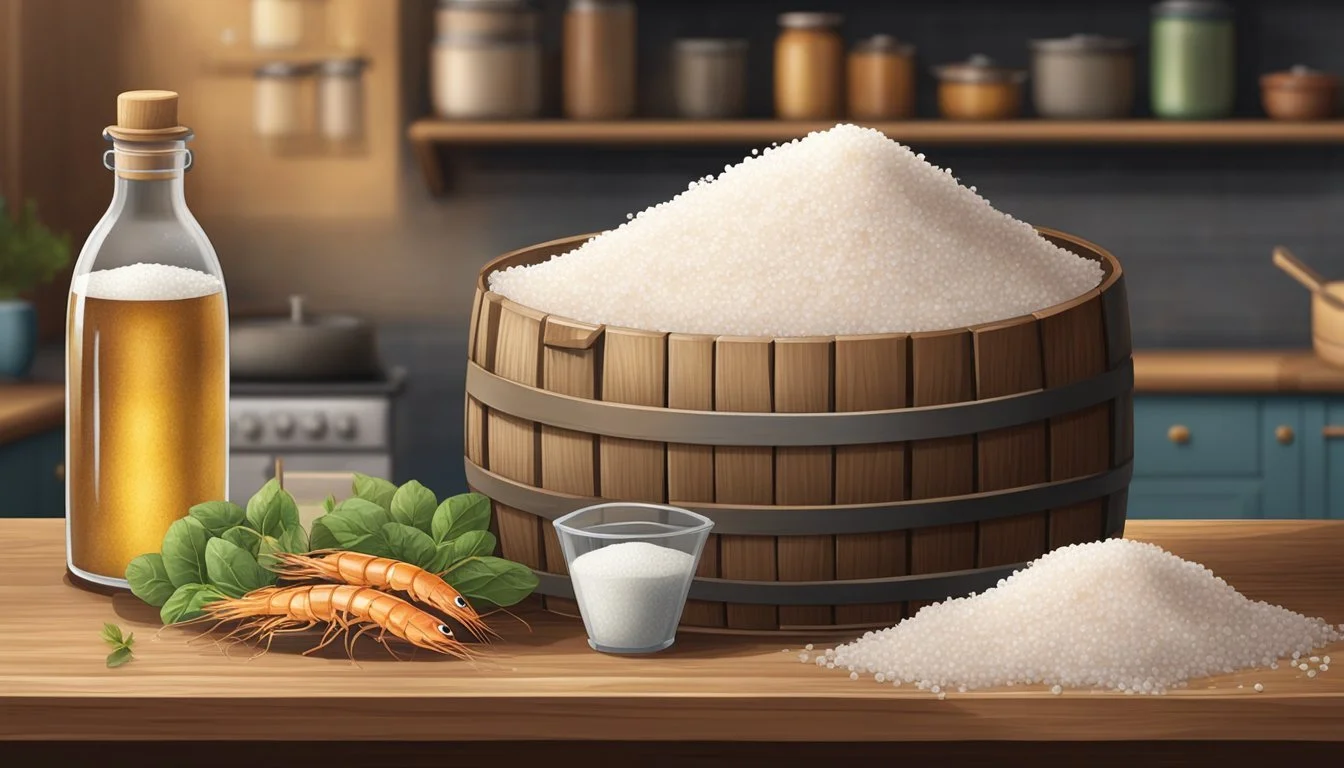How to Ferment Cincalok
A Step-by-Step Guide to Malaysian Fermented Shrimp
Cincalok is a traditional Malaysian condiment renowned for its unique flavor profile, which is a result of fermenting small shrimps or krill with salt and cooked rice. This specialty, particularly popular in the states of Johor, Malacca, and Penang, offers a combination of salty, sour, and umami notes that characterize Southeast Asian cuisine. Fermentation, a practiced art in this region, not only enhances the taste and shelf life of the shrimps but also incorporates into dishes a piece of the cultural mosaic that Malaysia represents.
To make cincalok at home, one would begin with selecting the right type of small shrimps, ensuring they are fresh to guarantee the best possible outcome. The process involves mixing these shrimps with salt and rice, the latter of which acts as a fermenting agent by introducing the necessary bacteria to kickstart the fermentation process. The mixture is then allowed to ferment under specific conditions for a period, usually several days, to achieve the desired level of fermentation, ultimately yielding a potent and flavorful condiment.
Cincalok is not only appreciated as a standalone condiment but also incorporated into various Malaysian dishes to add depth and complexity. Its versatility allows it to pair well with a plethora of ingredients, from seasoning stir-fried noodles to being a key player in marinating meats, highlighting its importance in the culinary practices of the region.
History and Origin of Cincalok
Cincalok is a traditional Malay condiment, with a heritage deeply rooted in the coastal areas of Malaysia, particularly the historical state of Malacca. The birth of cincalok dates back to the time when the Portuguese occupied Malacca, infusing the local culinary landscape with their food preservation techniques.
The Peranakan community, known for their hybrid culture resulting from Chinese settlers marrying into Malay families, and the Kristang, descendants of Portuguese colonials, have all played roles in preserving and popularizing cincalok. It's a celebration of Malaysia's multicultural tapestry, particularly within the communities that exist along the straits.
Primary Ingredients Used in Cincalok:
Small shrimp or krill (udang geragau)
Salt
Cooked rice (for fermentation)
The process involves fermenting small shrimps with a mixture of salt and cooked rice. Over time, it develops a distinct flavor profile—salty and sour with a pungent aroma that is highly valued in local cuisine.
In comparison to its Filipino counterpart, bagoong alamang, which is also a shrimp-based fermented condiment, cincalok typically incorporates whole small shrimps rather than just the paste and has a unique sour note from the fermentation process.
Today, cincalok remains a cherished condiment in Malaysian households, serving as a piquant reminder of the country's historical trade routes and the convergence of cultural influences that shape its food traditions.
Understanding Cincalok
Cincalok is a unique condiment integral to Malaysian gastronomy, made from fermented small shrimps, offering a strong aroma and a complex flavor profile to various dishes.
Defining Cincalok
Cincalok is a traditional Southeast Asian condiment made primarily from fermented tiny shrimps known as udang geragau or geragau. These shrimps are mixed with salt and cooked rice and allowed to ferment to develop its characteristic pungent smell and its distinctive salty-sour taste. Typically, this mixture is left to ferment for several days, during which the rice acts as a substrate for the fermentation, enhancing the flavor and preserving the shrimps. Once ready, cincalok is used in a variety of culinary applications, often as a dip or a flavoring agent in cooking.
Cincalok in Malay Culture
In Malay culture, cincalok is more than just a condiment; it embodies a culinary tradition passed down through generations. The practice of fermenting shrimps is an age-old method of preservation that imparts a depth of flavor to dishes. It's particularly popular in regional cuisines of Malacca, Johor, and Penang, and it's commonly found in home-cooked meals and at local eateries. Cincalok is also part of the broader Southeast Asian tradition of fermented seafood products, which includes Filipino bagoong and Thai pla ra, showcasing similar fermentation techniques.
Health Benefits and Nutrition
Cincalok, a traditional Malaysian fermented shrimp condiment, contributes to a nutritious diet while offering distinctive flavors. Its fermentation process enhances the bioavailability of nutrients and adds beneficial bacteria that support gut health.
Nutritional Profile
Calories: Cincalok is low in calories, making it a light addition to meals that can enhance flavor without significantly increasing caloric intake.
Cholesterol & Protein: Being a shrimp-based product, it contains cholesterol, but also offers a good source of protein which is vital for muscle repair and growth.
Minerals: It provides essential minerals such as calcium and potassium. Calcium is crucial for bone health, while potassium supports nerve function and muscle contractions.
Calories: Low
Protein: Good source
Cholesterol: Present
Calcium: Contributes to RDI
Potassium: Contributes to RDI
Health Considerations
Consumers should note that cincalok contains a considerable amount of sodium due to the salt used in the fermentation process. While sodium is essential for fluid balance and nerve function, excessive intake can lead to health issues such as hypertension.
As with any fermented food, cincalok introduces probiotics to the diet, which can help maintain a healthy gut microbiota.
Individuals with a shellfish (What wine goes well with shellfish?) allergy should avoid cincalok due to potential allergic reactions. It's also prudent for those monitoring cholesterol intake to consume cincalok in moderation.
Sodium Content: High, monitor intake
Probiotics: Contributes to gut health
Allergy Precaution: Not suitable for those with a shellfish allergy
Cholesterol: Monitor if concerned with cholesterol intake
Culinary Uses
Cincalok, a traditional Malaysian condiment made from fermented small shrimps, holds a unique place in Southeast Asian cuisine. Its flavor profile adds depth to various dishes, making it a versatile ingredient in the culinary world.
Cincalok as a Condiment
Cincalok typically shines as a condiment, enhancing meals with its distinctive combination of salty and sour notes. One can serve it simply with a sprinkling of fried shallots on top to add a crispy texture. In Nyonya cuisine, it often graces the table as a piquant garnish, offering a burst of umami to the palate. It's common to see it paired with dishes that benefit from a sharp, fermented accent.
Incorporating Cincalok in Recipes
Beyond its role as a condiment, cincalok lends itself to a variety of recipes within Malaysian cuisine. Here are some ways in which it merges into cooking:
Cincalok Braised Chicken: Marinating chicken in cincalok imparts an exquisite tang and complexity to the braising sauce, elevating the poultry dish.
Omelet: Whisking cincalok into eggs before frying creates an omelet brimming with localized flavors, marrying the silkiness of the eggs with the cincalok’s umami.
Fried Rice: By incorporating cincalok into fried rice, chefs invigorate a simple staple with robust, multi-layered flavors. It harmonizes with the rice, vegetables, and proteins in the dish.
These culinary applications show how cincalok transcends its condiment status, becoming a dynamic ingredient in Malaysian and Nyonya cooking traditions.
Preparation of Cincalok
Fermenting Cincalok takes careful selection of ingredients and precise control over the fermentation process. This traditional Malaysian condiment involves tiny shrimps and relies on a balance of salt, sugar, and time to develop its characteristic flavor.
Selecting Ingredients
The cornerstone of Cincalok is the tiny shrimps, known locally as geragau, which are typically sourced from coastal areas like Limbongan, Tanjung Kling, or Pantai Klebang. It's important that these shrimps are fresh and retain their whole form to ensure a quality end product. Alongside the shrimps, salt acts as a preservative and flavor enhancer, while sugar is often included to moderate the sourness developed during fermentation.
Ingredients needed:
Fresh tiny shrimps (
geragau)Pure salt (preferably non-iodized)
Sugar (optional, to taste)
The Fermentation Process
Once the ingredients are gathered, the tiny shrimps are thoroughly washed to remove impurities. The cleaned shrimps are then mixed with an equal weight of salt and sometimes a bit of sugar. This mixture is left to ferment in a closed container under the sun. The preferred duration of fermentation ranges from three days to two weeks, depending on the desired intensity of flavor and local climate conditions. The fermenting container needs to be air-tight to avoid spoiling and contamination.
Key steps:
Wash the shrimps thoroughly.
Mix shrimps with an equal weight of salt (and sugar, if used).
Place the mixture in a sealed container.
Leave to ferment under the sun for up to two weeks.
Seasoning and Flavor Enhancement
Once the fermentation is complete, the Cincalok can be further seasoned to taste. Additional sugar may be added to balance the salty and sour notes. Some recipes also include the addition of limbongan, a local spice that can introduce another layer of flavor. The final step is jarring and sealing the Cincalok for storage or immediate use, whereupon its unique taste can be incorporated into various Malaysian dishes.
Suggestions for extra flavor:
Increase sugar content slightly for a balanced taste.
Add limbongan for an authentic local twist.
Tips for Consuming Cincalok
When exploring the unique flavors of Cincalok, one should consider its acquired taste and pungent odor. Pairing it with the right ingredients can enhance its salty profile.
Acquiring the Taste
Cincalok is an East Asian fermented shrimp condiment known for its strong, pungent smell and salty flavor. Newcomers should start with small amounts, possibly mixed with other condiments, to gradually appreciate its complex taste.
Serving Suggestions
To enjoy Cincalok, one can try incorporating it into various dishes:
Condiment: Use it sparingly as a condiment, paired with freshly sliced shallots and lime juice for a zesty kick.
Cooking Ingredient: Blend it into traditional recipes such as Ayam Cincalok (chicken cooked with Cincalok) to infuse a savory depth.
Dip: Mix with other dips for a less intense flavor, suitable for East Asian cuisine.
Storage and Preservation
Storing Cincalok properly ensures its longevity and taste:
Refrigerate: Keep the product in an airtight container in the refrigerator to maintain its quality.
Glass Bottles: Often found in glass bottles, Cincalok should be kept away from direct sunlight and heat sources to avoid spoilage.
Cincalok Variations
Cincalok, a Malaysian fermented shrimp condiment, boasts a spectrum of variations influenced by regional practices and similar products in neighboring countries.
Regional Varieties
Different regions in Malaysia offer their unique take on cincalok. While the base ingredients typically include small shrimps or krill, salt, and cooked rice, the condiment's flavor profile can vary. For example, Johor, Malacca, and Penang have subtle differences in their cincalok recipes, potentially altering the saltiness or sourness due to local taste preferences or the fermentation process.
Similar Fermented Shrimp Products
To understand Cincalok's position in the broader scope of fermented seafood, one can look at other similar products:
Bagoong Alamang (Philippines): As a Filipino counterpart, it is made from minute shrimp or krill, salt, and sometimes sugar. It often appears more as a paste compared to Cincalok's whole shrimp presentation.
Kimchi (Korea): While not a shrimp product, kimchi shares the fermentation aspect with cincalok. Ingredients like brined seafood enhance kimchi's flavor, illustrating the diverse use of fermentation in Asian cuisines.
It is essential to recognize the cultural and culinary nuances influencing the variations of cincalok and its counterparts within Asia.
Where to Find Cincalok
Cincalok, a traditional Southeast Asian condiment of fermented small shrimps, can be sourced in various locations depending on its use, whether for home cooking or dining in restaurants.
Purchasing Cincalok
Consumers seeking to purchase Cincalok for home use may find it available at:
Asian grocery stores: These specialty stores often stock a range of fermented foods and condiments, including Cincalok.
Markets: In regions where Southeast Asian foods are popular, local markets might carry Cincalok, especially those with a focus on international or exotic ingredients.
Grocery stores: While less common, some larger mainstream grocery stores with an international aisle might offer Cincalok.
When searching for Cincalok, it is often found bottled or jarred, sometimes produced by local cottage industries.
Cincalok in Modern Cuisine
Restaurants that feature Southeast Asian dishes may incorporate Cincalok, particularly those specializing in Malaysian cuisine. One might encounter it in:
Malaysian restaurants: These establishments often use Cincalok as a condiment or ingredient in various traditional dishes.
Fusion eateries: Chefs at contemporary restaurants might use Cincalok to add unique flavors to innovative dishes, combining traditional and modern culinary techniques.
Recipes Featuring Cincalok
Cincalok, a traditional Malaysian condiment of fermented small shrimps, features prominently in various local dishes. Utilized for its salty and umami-rich flavor, cincalok elevates simple ingredients such as eggs and chicken, giving birth to savory delights that are simple to prepare.
Simple Cincalok Omelet
Ingredients:
Eggs: 2
Cincalok: 1 tablespoon
Onions, finely chopped: 1 tablespoon
Salt to taste
Pepper: a dash
Oil: for cooking
Method:
Beat the eggs in a bowl.
Mix in cincalok, onions, salt, and pepper.
Heat oil in a frying pan over medium heat.
Pour the egg mixture into the pan, cook until set, then fold and serve.
Cincalok Braised Chicken
Ingredients:
Chicken thighs, skin-on: 4 pieces
Cincalok: 2 tablespoons
Onions, sliced: 1 medium
Garlic, minced: 4 cloves
Red chillies, sliced: 2
Lemongrass, bruised: 1 stalk
Oil: 2 tablespoons
Water or chicken stock: 1/2 cup
Sugar: to taste
Salt to taste
Method:
In a pot, heat oil over medium heat.
Sauté onions, garlic, chillies, and lemongrass until fragrant.
Add chicken and brown on all sides.
Stir in cincalok, then add water or stock to cover.
Simmer until the chicken is cooked and the gravy has thickened.
Cincalok Fried Rice
Ingredients:
Cooked rice, cooled: 2 cups
Cincalok: 2 tablespoons
Garlic, minced: 2 cloves
Small shrimps, peeled: 1/2 cup
Eggs, beaten: 2
Green onions, chopped: 1/4 cup
Oil: for cooking
Salt to taste
Pepper: a dash
Method:
Heat oil in a wok over high heat.
Fry garlic until golden, add shrimps, and cook until pink.
Push shrimps aside, pour in eggs and scramble.
Add rice, cincalok, and mix thoroughly.
Season with salt and pepper, stir in green onions before serving.
Pairing with Other Foods
When incorporating Cincalok into various dishes, it is essential to consider flavors that complement its unique taste and to create a balanced blend with other ingredients. This section will explore how to achieve culinary harmony.
Complementary Flavors
Cincalok, known for its salty and sour notes, pairs exceptionally well with ingredients that bring a contrasting profile. Chilli and garlic add a spicy kick that elevates Cincalok's umami character. Lemongrass provides a fragrant citrus note that mitigates the pungency. The use of tamarind paste can enhance the sour aspect, while a touch of white pepper adds nuanced heat. In Penang and other Malaysian regions, the use of fresh shallots and red chilies is common to balance the flavor with a slight sweetness and a vibrancy in color and taste.
Chilli and Garlic: Add heat and pungency, excellent for stir-fries.
Lemongrass: Offers a citrusy contrast, ideal for marinades.
Tamarind Paste: Intensifies sourness, pairing well with the salty shrimp.
White Pepper: Subtle, warm spice that complements the ferment.
Creating Balanced Dishes
To create harmony in dishes featuring Cincalok, one should aim to temper its robust flavor without overshadowing the other ingredients. Spicy elements should be used judiciously to accentuate the umami flavor without overpowering it. Raw applications like salsas or salads allow for the incorporation of chillis to cut through the richness. Cooked preparations should integrate garlic and lemongrass to mellow out the sharpness and add aromatic depth. The addition of tamarind in sauces can bring balance with its tanginess.
Salads/Salsas: Cincalok with diced chillies and shallots for a piquant touch.
Stir-fries/Marinades: Use garlic and lemongrass to offset the fermented taste.
Sauces: Tamarind adds a sour dimension, complementing Cincalok's flavor profile.





